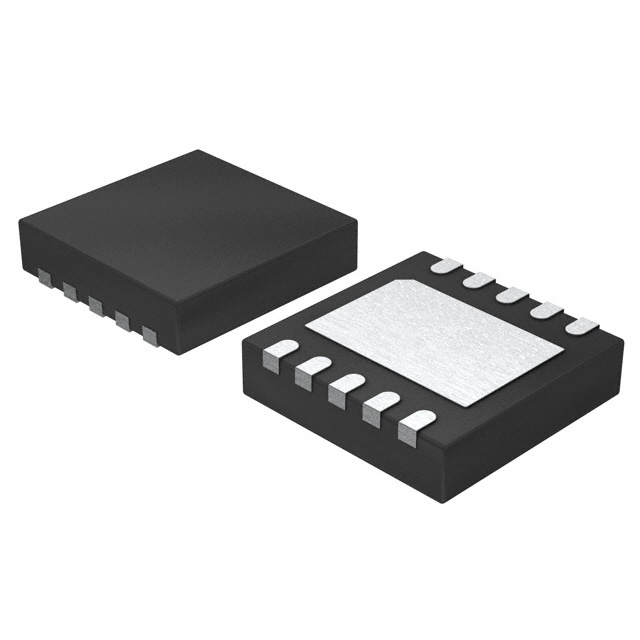Consulte las especificaciones para obtener detalles del producto.

LTC2626IDD-1#TRPBF
Product Overview
Category
The LTC2626IDD-1#TRPBF belongs to the category of digital-to-analog converters (DACs).
Use
This product is primarily used for converting digital signals into analog voltages.
Characteristics
- High precision and accuracy
- Low power consumption
- Small form factor
- Wide operating temperature range
Package
The LTC2626IDD-1#TRPBF comes in a small 12-pin DFN package.
Essence
The essence of this product lies in its ability to provide accurate analog voltage outputs based on digital input signals.
Packaging/Quantity
The LTC2626IDD-1#TRPBF is typically packaged in reels and is available in quantities suitable for both prototyping and production purposes.
Specifications
- Resolution: 12 bits
- Number of Channels: 1
- Supply Voltage Range: 2.7V to 5.5V
- Output Voltage Range: 0V to VREF
- Operating Temperature Range: -40°C to 85°C
- Interface: SPI-compatible
Detailed Pin Configuration
- VDD: Power supply voltage
- GND: Ground reference
- CS: Chip select input
- SCK: Serial clock input
- SDI: Serial data input
- LDAC: Load DAC input
- REF: Reference voltage input
- AGND: Analog ground reference
- OUT: Analog output voltage
- NC: No connection
- NC: No connection
- VOUT: Output voltage reference
Functional Features
- High-resolution digital-to-analog conversion
- SPI-compatible interface for easy integration with microcontrollers
- Low power consumption for energy-efficient applications
- Fast settling time for rapid response to digital input changes
- Internal reference voltage for simplified circuit design
Advantages and Disadvantages
Advantages
- High precision and accuracy in analog voltage output
- Wide operating temperature range allows for use in various environments
- Small form factor enables integration into space-constrained designs
- Low power consumption prolongs battery life in portable devices
Disadvantages
- Limited to single-channel output
- Requires an external reference voltage source
Working Principles
The LTC2626IDD-1#TRPBF operates by converting digital input signals received through the SPI interface into corresponding analog voltages. It utilizes a 12-bit resolution to provide high precision and accuracy in the conversion process. The internal reference voltage ensures consistent performance across different operating conditions.
Detailed Application Field Plans
The LTC2626IDD-1#TRPBF finds applications in various fields, including:
- Industrial Automation: Precise control of analog outputs in industrial machinery and equipment.
- Test and Measurement: Generating accurate analog signals for testing and calibration purposes.
- Audio Equipment: Producing high-quality audio signals in audio processing systems.
- Instrumentation: Providing precise voltage references in scientific instruments.
- Automotive Electronics: Controlling analog functions in automotive systems.
Detailed and Complete Alternative Models
- LTC2626IDD-2#TRPBF: Similar to LTC2626IDD-1#TRPBF but with dual-channel output capability.
- LTC2626IDD-4#TRPBF: Four-channel version of the LTC2626IDD series DAC.
- LTC2626IDD-8#TRPBF: Eight-channel variant for applications requiring multiple analog outputs.
These alternative models offer expanded functionality and flexibility based on specific application requirements.
Word count: 511 words
Enumere 10 preguntas y respuestas comunes relacionadas con la aplicación de LTC2626IDD-1#TRPBF en soluciones técnicas
Sure! Here are 10 common questions and answers related to the application of LTC2626IDD-1#TRPBF in technical solutions:
Q1: What is LTC2626IDD-1#TRPBF? A1: LTC2626IDD-1#TRPBF is a specific model of digital-to-analog converter (DAC) manufactured by Linear Technology (now part of Analog Devices). It is used to convert digital signals into analog voltage outputs.
Q2: What is the resolution of LTC2626IDD-1#TRPBF? A2: LTC2626IDD-1#TRPBF has a resolution of 12 bits, meaning it can represent analog voltages with 4096 discrete levels.
Q3: What is the operating voltage range of LTC2626IDD-1#TRPBF? A3: LTC2626IDD-1#TRPBF operates from a single supply voltage ranging from 2.7V to 5.5V.
Q4: How many channels does LTC2626IDD-1#TRPBF have? A4: LTC2626IDD-1#TRPBF is a dual-channel DAC, which means it has two independent output channels.
Q5: What is the maximum output voltage range of LTC2626IDD-1#TRPBF? A5: The maximum output voltage range of LTC2626IDD-1#TRPBF is determined by the reference voltage applied to its VREF pin. It can be adjusted within the supply voltage range.
Q6: Can LTC2626IDD-1#TRPBF operate in both unipolar and bipolar modes? A6: Yes, LTC2626IDD-1#TRPBF can be configured to operate in either unipolar mode (0V to VREF) or bipolar mode (-VREF/2 to +VREF/2) for each channel independently.
Q7: What is the interface used to communicate with LTC2626IDD-1#TRPBF? A7: LTC2626IDD-1#TRPBF uses a standard 3-wire SPI (Serial Peripheral Interface) for communication with a microcontroller or other digital devices.
Q8: Can LTC2626IDD-1#TRPBF be used in precision applications? A8: Yes, LTC2626IDD-1#TRPBF is designed for precision applications and offers low integral nonlinearity (INL) and differential nonlinearity (DNL) specifications.
Q9: Does LTC2626IDD-1#TRPBF have any built-in reference voltage source? A9: No, LTC2626IDD-1#TRPBF requires an external reference voltage source connected to its VREF pin.
Q10: What are some typical applications of LTC2626IDD-1#TRPBF? A10: LTC2626IDD-1#TRPBF can be used in various applications such as industrial process control, test and measurement equipment, audio systems, motor control, and programmable power supplies.
Please note that the answers provided here are general and may vary depending on specific application requirements. It is always recommended to refer to the datasheet and consult with the manufacturer for detailed information.

